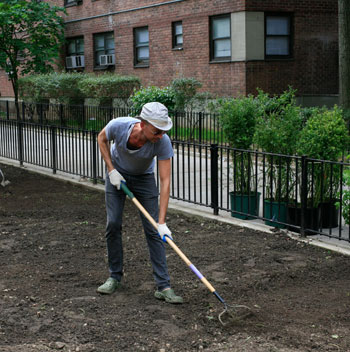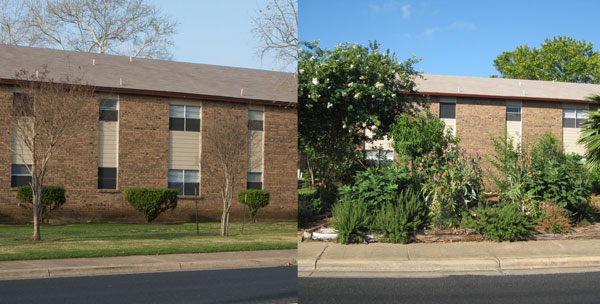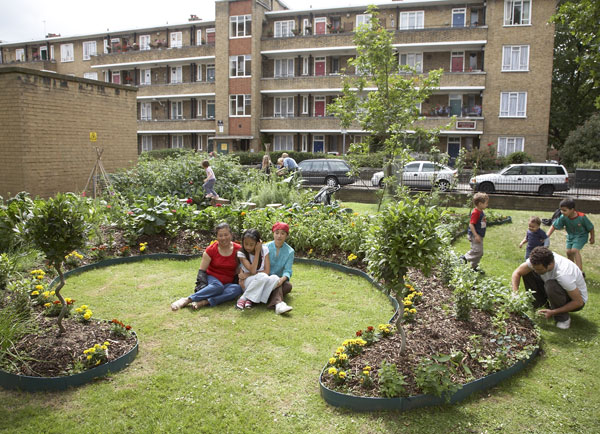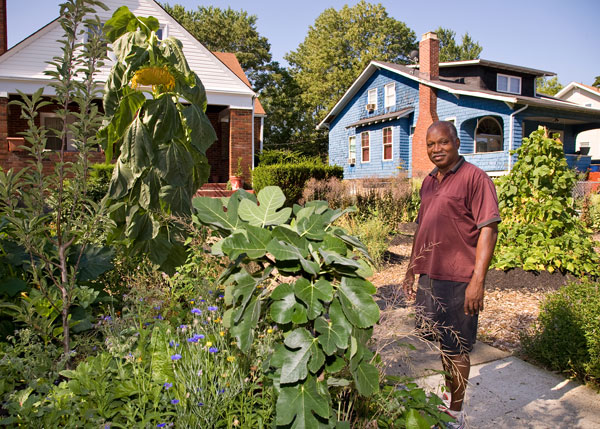News
Interview with Fritz Haeg
 Image credit: Oto Gillen
Image credit: Oto Gillen
In the new edition of your book "Edible Estates: Attack On The Front Lawn," you argue that ripping out front lawns and replacing them with fruit, vegetable, and herb gardens can "ignite a chain reaction of thoughts that question other antiquated conventions of home, street, neighborhood, city." Why does this start with the front lawn?
The front lawn is wrapped up in our ideas of the American dream. It's a very iconic and loaded space. When you remove it and replace it with something else, you are questioning all of the values implicit in the lawn and what it stands for. It is significant to me not just because it's a private space that's very public - so visible in our cities and such an obvious opportunity to reconsider - but also because of what it symbolizes. The easiest first step for the urban citizen who wants to make a visible impact on their city is to go out that front door and get their hands in the dirt. It is the leading wedge into more complex and ambitious civic activity.
While of course I have an earnest interest in growing food at home, what really excites me is the sense of attacking the archaic values of the conventional manicured landscape and replacing it with casual, wild, and handmade gardens that propose an alternative set of values which are more evolved, civilized, healthy, participatory, and full of pleasure. If you see your neighbors remove their lawn and replace it with a space to grow food, suddenly the city opens up for you. I hope this leads to the collective imaginings of a more participatory city that's less like TV and more active, inspiring landscapes and cities that are not there for passive viewing but for active participation.
The front lawn is such an antiquated tradition that evolved with a way of living that doesn't exist anymore. Public lawns were trimmed by grazing animals, and hidden food gardens were maintained by slaves or an underpaid staff living downstairs. Our current ideas of beauty in the landscape are still connected to this system - so I want to know what our landscapes and cities could look like when the people who actually live there are more personally involved.
In an editorial for The Guardian you wrote "We know that the lawn is essentially ecological genocide. Everything but the precious blades of grass must die in the name of that luxurious green carpet." How do we get to a place where lawns cover more than 50,000 square miles of the country or an area the size of New York State?
Certain 19th century planners and developers were promoting the front lawn as a well-intentioned common green that would connect us all - but ironically it also perpetuated the illusion of the single family home as a refuge for complete independence and domination- bringing us to the lawn of today, which is not connective at all, but quite isolating. With the post-war period, the end of the victory garden movement, and the explosion of home ownership, the pervasive American lawn really takes off as the de-facto landscape to surround the home. The rise of the lawn in the late '40s and early '50s is connected to a blind celebration of industrial technology and an obsession with short-term convenience. This coincides with the crest of the modern movement, which represses eccentricities of place in favor of a truly international movement. This ideal of sameness and placelessness promotes the notion that what is right for one place is right for everywhere. The emergence of the American lawn is so wrapped up in the economic, political, and industrial system of it’s time, that you can't separate out. The question isn't why we started to plant lawns; but why do we continue to?
A number of cities including Detroit and San Francisco have invested in urban farming, encouraging small-scale plots to spread throughout their cities. However, in a recent discussion on the business model for urban agriculture at the National Building Museum, some experts argue that "there isn't any money to be made from this." Do you think urban agriculture needs to make money? Can it expand as a nonprofit model?
With my recent projects, I haven't been going beyond the modest scale of people growing their own food at home. What happens when individuals independently go out their front door and plant food? It's as simple as that. I'm interested, open, and excited about all of the other scales, permutations and possibilities beyond that. I am for anything that makes visible in our cities the systems that make our lives there possible. But I have been turning down invitations to pursue larger projects with more red tape and more constituents because I'm interested in operating at the cellular level of one family, one individual. Because that's viral, it can spread, anyone can do it, and that's powerful.
The more this activity moves back to a top-down, capitalistic, industrialized system that needs to turn a profit, the more you're just perpetuating the problems that led us to the mess that we have inherited. While we also need top-down strategies, I don't see any reason for me to go far beyond families growing food where they live. I don't know why it has to be more complicated than that.
In denser urban areas like New York City where the real estate is really pricy, some apartment owners are putting in green roofs and wall gardens. What do you think of this trend? Should cities incentivize the use of these in residential or commercial high rises?
We should be actively questioning all the land-use assumptions in our cities, the lost opportunities, the space that is neglected and not fully activated. I've been specifically focused on that space between the front door and the street because it's the most pervasive visible public social place for us to re-imagine. It's also the site for the most dramatic possible change because it is typically so thoroughly isolating, polluting, and wasteful - and how satisfying to that with very little money and effort it can be transformed over a weekend into a nexus for productive, healthy, beautiful and social activity.
 Edible Estates Regional Prototype Garden #5, Austin, Texas. Commissioned by Arthouse / Fritz Haeg
Edible Estates Regional Prototype Garden #5, Austin, Texas. Commissioned by Arthouse / Fritz Haeg
The regional prototype gardens you feature in your book are in different locations across the U.S. and Europe, and have different climates and levels of population density. The edible estates in Maplewood, New Jersey and Salina, Kansas are more suburban, while the ones in Baltimore and Manhattan present urban models. How do the design strategies need to be different in urban and suburban areas? What are the challenges for each type?
The design of the London garden, featuring a series of Arabesque shapes, was inspired by local royal parks. However, more importantly, it was designed to accommodate a lot of different people coming through the garden, including children and families with very different levels of involvement. It needed to be designed differently than a garden just for a single family - where we know who's going to be there tending it. The narrow beds allow gardeners to reach in and tend them without having to step in the actual planting areas, while also creating outdoor spaces for people to hangout.
 Regional Prototype Garden #4, London, England. Commissioned by Tate Modern / Heiko Prigge
Regional Prototype Garden #4, London, England. Commissioned by Tate Modern / Heiko Prigge
Some of the gardens I've done for suburban front yards are wild, productive, pleasure garden landscapes that don’t even have footpaths. The design approach depends on how the family lives, what they are open to, and what's appropriate in the neighborhood. I want every garden to be different, and respond to it’s particular gardeners and location.
 Regional Prototype Garden #6, Baltimore, Maryland. Commissioned by Contemporary Museum, Baltimore / Leslie Furlong
Regional Prototype Garden #6, Baltimore, Maryland. Commissioned by Contemporary Museum, Baltimore / Leslie Furlong
In many parts of the U.S. taking out your lawn and putting in a garden breaks local zoning codes. When do you think these front-yard gardens will be widely accepted? Until then, what do you recommend to those who want to put something in now but will break the rules?
I haven't yet had the opportunity to plant a garden in a place that's illegal, but I would really love to take that on. Just the very notion that someone wouldn't be allowed to grow food where they live is quite astounding. The fact that someone like me should even have to do a project about people publicly growing food at home is just kind of ridiculous! I would like to think the people defending the policies that prevent us from growing food where we live are starting to feel embarrassed.
However, the sort of people who move to places with very restrictive homeowner association covenants probably want predictable industrial landscapes, and maybe for them a wild vegetable garden in front of their neighbor’s house could be interpreted as a threat, a sign of anarchy. What could be seen by them as a sign of the unraveling of civilization, for others could be seen as real progress.
It seems anecdotally, and from the mainstream press, that there's more interest in growing your own food at home, but when you look on the ground at what people are actually doing across the country it doesn't seem to have made much difference at all. But I suppose these movements develop gradually and it takes a while for them to find their way to the masses. A lot of it just has to do with ideas of beauty and pleasure. One day people think that growing food is a chore and it's work and a vegetable garden is ugly and anarchistic, but the times and circumstances change, and so do those attitudes. We can say that the junk we call ‘food’ sold at grocery stores is making us sick, and is only cheap in the very short term. We can say that lawns are isolating, toxic, wasteful, and polluting. But I don't think people are motivated by pressure, or guilt, or even problematic evidence. People are motivated by pleasure. Having a causal, wild, productive, diverse, beautiful vegetable garden is frankly a lot more fun than watering and mowing and pouring pesticides on our lawns. For me, it comes down to pleasure and I think that's the best point of entry into big cultural shifts like this.
Lastly, on a very practical level, so you've decided to take out your lawn and put in a garden. How does someone actually just get their garden started? What are the first steps?
The Edible Estate gardens I've done are entirely established over a weekend with the family, their friends, and local volunteers. We rip the entire lawn out in one day and plant the garden the next. That's not a viable possibility for most families, but, you could also do it very gradually over time, slowly replacing the sterile manicured monocultures with herbs, fruit, grains, and vegetables.
What's so great about growing food and creating your own kitchen garden, vegetable garden, fruit orchard, berry patch, is that there's no right way. There's no one way. It's not like a lawn where you can do it the same anywhere. Once you go out your door and start growing food, suddenly you're paying attention to your climate, your tastes, how you eat, what will do well there, what looks good, who your neighbors are, what the people on the street think. You don't get this if you're just out there mowing your lawn once a week.
Fritz Haeg is an artist, designer, gardener, and writer currently on a 2010-11 Rome Prize Fellowship; his book "Edible Estates: Attack on the Front Lawn" was just rereleased in a second expanded edition by Metropolis Books. www.fritzhaeg.com.
Interview conducted by Jared Green.